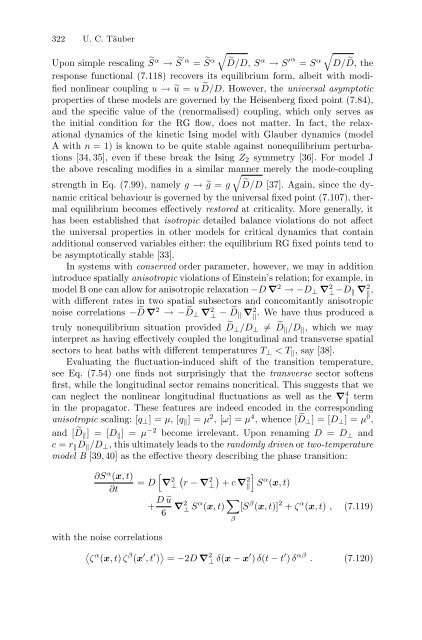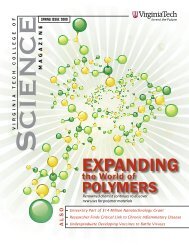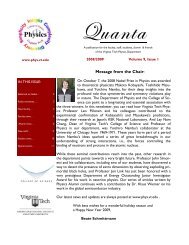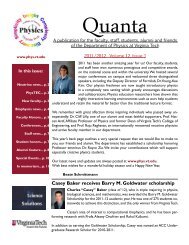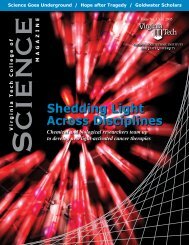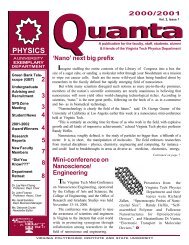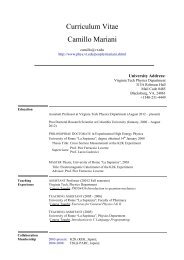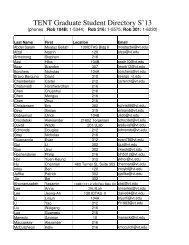Springer Lecture Notes in Physics 716
Springer Lecture Notes in Physics 716
Springer Lecture Notes in Physics 716
You also want an ePaper? Increase the reach of your titles
YUMPU automatically turns print PDFs into web optimized ePapers that Google loves.
322 U. C. Täuber<br />
√<br />
Upon simple rescal<strong>in</strong>g ˜S α → ˜S ′α = ˜S α ˜D/D, S α → S ′α = S<br />
√D/ α ˜D, the<br />
response functional (7.118) recovers its equilibrium form, albeit with modified<br />
nonl<strong>in</strong>ear coupl<strong>in</strong>g u → ũ = u ˜D/D. However, the universal asymptotic<br />
properties of these models are governed by the Heisenberg fixed po<strong>in</strong>t (7.84),<br />
and the specific value of the (renormalised) coupl<strong>in</strong>g, which only serves as<br />
the <strong>in</strong>itial condition for the RG flow, does not matter. In fact, the relaxational<br />
dynamics of the k<strong>in</strong>etic Is<strong>in</strong>g model with Glauber dynamics (model<br />
A with n = 1) is known to be quite stable aga<strong>in</strong>st nonequilibrium perturbations<br />
[34, 35], even if these break the Is<strong>in</strong>g Z 2 symmetry [36]. For model J<br />
the above rescal<strong>in</strong>g modifies <strong>in</strong> a similar manner √ merely the mode-coupl<strong>in</strong>g<br />
strength <strong>in</strong> Eq. (7.99), namely g → ˜g = g ˜D/D [37]. Aga<strong>in</strong>, s<strong>in</strong>ce the dynamic<br />
critical behaviour is governed by the universal fixed po<strong>in</strong>t (7.107), thermal<br />
equilibrium becomes effectively restored at criticality. More generally, it<br />
has been established that isotropic detailed balance violations do not affect<br />
the universal properties <strong>in</strong> other models for critical dynamics that conta<strong>in</strong><br />
additional conserved variables either: the equilibrium RG fixed po<strong>in</strong>ts tend to<br />
be asymptotically stable [33].<br />
In systems with conserved order parameter, however, we may <strong>in</strong> addition<br />
<strong>in</strong>troduce spatially anisotropic violations of E<strong>in</strong>ste<strong>in</strong>’s relation; for example, <strong>in</strong><br />
model B one can allow for anisotropic relaxation −D ∇ 2 →−D ⊥ ∇ 2 ⊥ −D ‖ ∇ 2 ‖ ,<br />
with different rates <strong>in</strong> two spatial subsectors and concomitantly anisotropic<br />
noise correlations − ˜D ∇ 2 →−˜D ⊥ ∇ 2 ⊥ − ˜D ‖ ∇ 2 ‖. We have thus produced a<br />
truly nonequilibrium situation provided ˜D ⊥ /D ⊥ ≠ ˜D ‖ /D ‖ , which we may<br />
<strong>in</strong>terpret as hav<strong>in</strong>g effectively coupled the longitud<strong>in</strong>al and transverse spatial<br />
sectors to heat baths with different temperatures T ⊥


